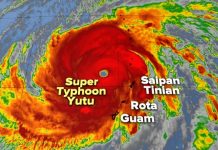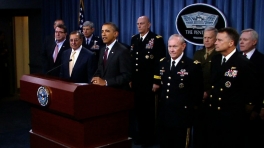
THE PRESIDENT: Good morning, everybody. The United States of America is the greatest force for freedom and security that the world has ever known. And in no small measure, that’s because we’ve built the best-trained, best-led, best-equipped military in history — and as Commander-in-Chief, I’m going to keep it that way.
Indeed, all of us on this stage — every single one of us — have a profound responsibility to every soldier, sailor, airman, Marine and Coast Guardsman who puts their life on the line for America. We owe them a strategy with well-defined goals; to only send them into harm’s way when it’s absolutely necessary; to give them the equipment and the support that they need to get the job done; and to care for them and their families when they come home. That is our solemn obligation.
And over the past three years, that’s what we’ve done. We’ve continued to make historic investments in our military — our troops and their capabilities, our military families and our veterans. And thanks to their extraordinary service, we’ve ended our war in Iraq. We’ve decimated al Qaeda’s leadership. We’ve delivered justice to Osama bin Laden, and we’ve put that terrorist network on the path to defeat. We’ve made important progress in Afghanistan, and we’ve begun to transition so Afghans can assume more responsibility for their own security. We joined allies and partners to protect the Libyan people as they ended the regime of Muammar Qaddafi.
Now we’re turning the page on a decade of war. Three years ago, we had some 180,000 troops in Iraq and Afghanistan. Today, we’ve cut that number in half. And as the transition in Afghanistan continues, more of our troops will continue to come home. More broadly, around the globe we’ve strengthened alliances, forged new partnerships, and served as a force for universal rights and human dignity.
In short, we’ve succeeded in defending our nation, taking the fight to our enemies, reducing the number of Americans in harm’s way, and we’ve restored America’s global leadership. That makes us safer and it makes us stronger. And that’s an achievement that every American — especially those Americans who are proud to wear the uniform of the United States Armed Forces — should take great pride in.
This success has brought our nation, once more, to a moment of transition. Even as our troops continue to fight in Afghanistan, the tide of war is receding. Even as our forces prevail in today’s missions, we have the opportunity — and the responsibility — to look ahead to the force that we are going to need in the future.
At the same time, we have to renew our economic strength here at home, which is the foundation of our strength around the world. And that includes putting our fiscal house in order. To that end, the Budget Control Act passed by Congress last year — with the support of Republicans and Democrats alike — mandates reductions in federal spending, including defense spending. I’ve insisted that we do that responsibly. The security of our nation and the lives of our men and women in uniform depend on it.
That’s why I called for this comprehensive defense review — to clarify our strategic interests in a fast-changing world, and to guide our defense priorities and spending over the coming decade — because the size and the structure of our military and defense budgets have to be driven by a strategy, not the other way around. Moreover, we have to remember the lessons of history. We can’t afford to repeat the mistakes that have been made in the past — after World War II, after Vietnam — when our military was left ill prepared for the future. As Commander in Chief, I will not let that happen again. Not on my watch.
We need a start — we need a smart, strategic set of priorities. The new guidance that the Defense Department is releasing today does just that. I want to thank Secretary Panetta and General Dempsey for their extraordinary leadership during this process. I want to thank the service secretaries and chiefs, the combatant commanders and so many defense leaders — military and civilian, active, Guard and reserve — for their contributions. Many of us met repeatedly — asking tough questions, challenging our own assumptions and making hard choices. And we’ve come together today around an approach that will keep our nation safe and our military the finest that the world have ever known.
This review also benefits from the contributions of leaders from across my national security team — from the departments of State, Homeland Security and Veterans Affairs, as well as the intelligence community. And this is critical, because meeting the challenges of our time cannot be the work of our military alone — or the United States alone. It requires all elements of our national power, working together in concert with our allies and our partners.
So I’m going to let Leon and Marty go into the details. But I just want to say that this effort reflects the guidance that I personally gave throughout this process. Yes, the tide of war is receding. But the question that this strategy answers is what kind of military will we need long after the wars of the last decade are over. And today, we’re fortunate to be moving forward from a position of strength.
As I made clear in Australia, we will be strengthening our presence in the Asia Pacific, and budget reductions will not come at the expense of that critical region. We’re going to continue investing in our critical partnerships and alliances, including NATO, which has demonstrated time and again — most recently in Libya — that it’s a force multiplier. We will stay vigilant, especially in the Middle East.
As we look beyond the wars in Iraq and Afghanistan — and the end of long-term nation-building with large military footprints — we’ll be able to ensure our security with smaller conventional ground forces. We’ll continue to get rid of outdated Cold War-era systems so that we can invest in the capabilities that we need for the future, including intelligence, surveillance and reconnaissance, counterterrorism, countering weapons of mass destruction and the ability to operate in environments where adversaries try to deny us access.
So, yes, our military will be leaner, but the world must know the United States is going to maintain our military superiority with armed forces that are agile, flexible and ready for the full range of contingencies and threats.
We’re also going to keep faith with those who serve, by making sure our troops have the equipment and capabilities they need to succeed, and by prioritizing efforts that focus on wounded warriors, mental health and the well-being of our military families. And as our newest veterans rejoin civilian life, we’ll keep working to give our veterans the care, the benefits and job opportunities that they deserve and that they have earned.
Finally, although today is about our defense strategy, I want to close with a word about the defense budget that will flow from this strategy. The details will be announced in the coming weeks. Some will no doubt say that the spending reductions are too big; others will say that they’re too small. It will be easy to take issue with a particular change in a particular program. But I’d encourage all of us to remember what President Eisenhower once said — that “each proposal must be weighed in the light of a broader consideration: the need to maintain balance in and among national programs.” After a decade of war, and as we rebuild the source of our strength — at home and abroad — it’s time to restore that balance.
I think it’s important for all Americans to remember, over the past 10 years, since 9/11, our defense budget grew at an extraordinary pace. Over the next 10 years, the growth in the defense budget will slow, but the fact of the matter is this: It will still grow, because we have global responsibilities that demand our leadership. In fact, the defense budget will still be larger than it was toward the end of the Bush administration. And I firmly believe, and I think the American people understand, that we can keep our military strong and our nation secure with a defense budget that continues to be larger than roughly the next 10 countries combined.
So again, I want to thank Secretary Panetta, Chairman Dempsey, all the defense leaders who are on this stage, and some who are absent, for their leadership and their partnership throughout this process. Our men and women in uniform give their very best to America every single day, and in return they deserve the very best from America. And I thank all of you for the commitment to the goal that we all share: keeping America strong and secure in the 21st century, and keeping our Armed Forces the very best in the world.
And with that, I will turn this discussion over to Leon and to Marty, who can explain more and take your questions.
So thank you very much. I understand this is the first time a President has done this. It’s a pretty nice room. (Laughter.)
Thank you guys.
(Pentagon january 5th, 2012. The White House, Office of the Press Secretary)














































